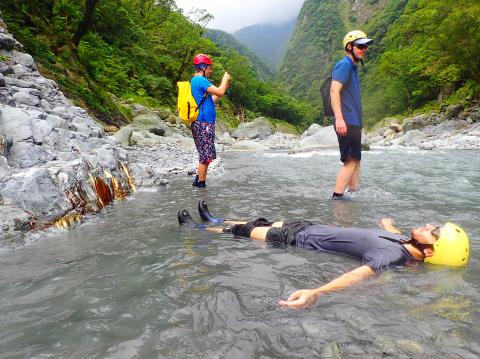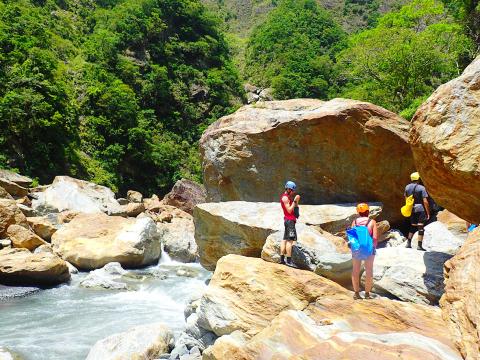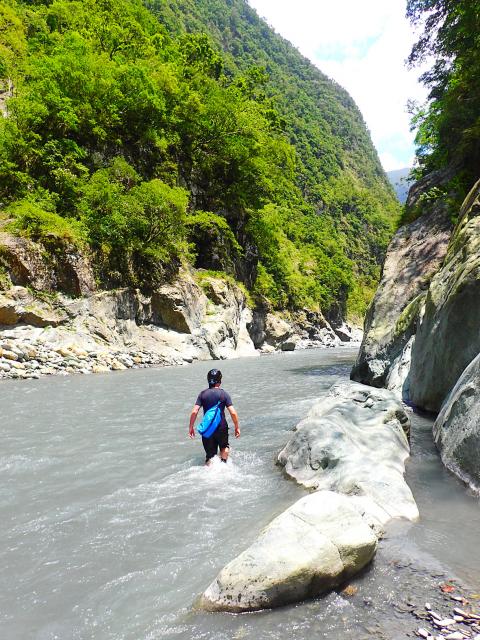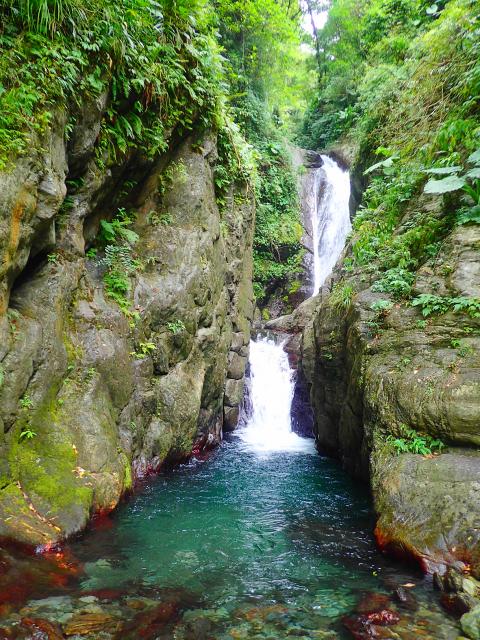With the long, cruel summer finally over and a refreshing chill in the air, my thoughts are turning towards the glories of Taiwan’s hot springs. However, not so much to the developed bath houses and resorts of Yangmingshan, Beitou and Wulai. (although those are very nice in their own way), as to the nation’s wild hot springs.
It’s still a couple of months too early to safely consider visiting most of the finest hot springs — Hayouxi (哈尤溪溫泉), Huisun (惠蓀溫泉) and Lulu (轆轆溫泉) — because it’s still technically rainy season in the southern half of Taiwan, and rivers will either be flowing too high to negotiate, or be subject to sudden and dangerous flash floods as thunderstorms hit. This is, however, a great time to visit the cluster of springs in the northeastern county of Yilan.
In November the summertime risk of heavy afternoon showers has gone, while the northeast monsoon fronts (which make Yilan wet and miserable for much of the winter) have yet to strengthen.

Photo: Richard Saunders
PRISTINE POOLS
Yilan County is rich in hot springs. While several famous ones at Jiaosi (礁溪) and Renze (仁澤) near Taipingshan, have long been tapped to provide water for commercial resorts, several remain natural, untouched and utterly beautiful.
A couple of easy-to-reach springs lie just a stone’s throw from each other on Highway 7, southwest of Yilan City. Fanfan (梵梵溫泉) and Paiguxi (排骨溪溫泉) hot springs are both just a short stroll from the road. Unfortunately, Fanfan is very popular these days, especially with four-wheel drive aficionados, who park their motorized monstrosities on the riverbed right beside the spring. Paiguxi, although still blissfully natural, is only big enough for a couple of bathers at any one time.

Photo: Richard Saunders
A bigger and more important group lies around the town of Nanao (南澳), one of the main settlements along the magnificent Suhua Highway (Highway No. 9). A remote trio lie deep in the mountains on tributaries of Hoping Creek, between Nanao and Taipingshan, but requires a strenuous three-day camping trip. Easier to reach are the four hot spring sources along Nanao Creek.
Flowing out of the mountains to the northwest, the creek passes right through the town before reaching the ocean just north of a beautiful stretch of cliff-bound coastline known as Mystery Coast (神秘海岸). The first two spring sources are easily accessible, thanks to a road that follows the first 6km or 7km of the river gorge. Bihou (碧候) and Area Four (四區) hot springs lie beside the road and have both been developed, with water piped into unsightly artificial pools. Wild hot spring lovers should motor straight past these without a second glance, park near Area Four Hot Spring and follow the track further in the direction of the blissfully untouched Laka Hot Spring (拉卡溫泉).
Walk ahead along the track through the woods parallel to the broad riverbed, which comes to an abrupt end after 500m. Clamber down to the riverbed and start walking upstream towards the wide gorge opening up ahead.

Photo: Richard Saunders
Presently the gorge narrows and the going becomes rougher — the only way is to clamber up, over and occasionally under huge boulders (some nearly as big as a house) washed down by past typhoons. In a few places the sides of the gorge squeeze the river between low cliffs of grey marble, and these stretches are only passable when the river is fairly low.
MINERAL WATER
About 90 minutes (or 3km) from the end of the road, the source will be obvious in rocks on the right bank of the river. The powerful source of hot spring water seeps out of a series of cracks in a low sill of rock about 20m in length. If the river is fairly low, the water at the base of the rock will be the temperature of a hot bath. At the far end, a small stream of scalding hot water (too hot to even stick your toe in) runs through the gravel and into the river, leaving a strip of brightly colored minerals as it flows.

Photo: Richard Saunders
Several kilometers upstream from Laka lies Yading Hot Spring (芽丁溫泉), but it’s normally approached from a completely different direction via a long mountain road beginning near Dongshan (冬山).
If time and weather conditions allow though, do walk upstream from Laka Hot Spring a little further (20 minutes) and your reward, on a side stream to the right after a sharp left-hand bend, is a beautiful small waterfall: a double plunge leaping into a deep pool of pure, bright blue-green water.
Richard Saunders is a classical pianist and writer who has lived in Taiwan since 1993. He’s the founder of a local hiking group, Taipei Hikers, and is the author of six books about Taiwan, including Taiwan 101 and Taipei Escapes. Visit his Web site at www.taiwanoffthebeatentrack.com.

On Jan. 17, Beijing announced that it would allow residents of Shanghai and Fujian Province to visit Taiwan. The two sides are still working out the details. President William Lai (賴清德) has been promoting cross-strait tourism, perhaps to soften the People’s Republic of China’s (PRC) attitudes, perhaps as a sop to international and local opinion leaders. Likely the latter, since many observers understand that the twin drivers of cross-strait tourism — the belief that Chinese tourists will bring money into Taiwan, and the belief that tourism will create better relations — are both false. CHINESE TOURISM PIPE DREAM Back in July

Taiwan doesn’t have a lot of railways, but its network has plenty of history. The government-owned entity that last year became the Taiwan Railway Corp (TRC) has been operating trains since 1891. During the 1895-1945 period of Japanese rule, the colonial government made huge investments in rail infrastructure. The northern port city of Keelung was connected to Kaohsiung in the south. New lines appeared in Pingtung, Yilan and the Hualien-Taitung region. Railway enthusiasts exploring Taiwan will find plenty to amuse themselves. Taipei will soon gain its second rail-themed museum. Elsewhere there’s a number of endearing branch lines and rolling-stock collections, some

Could Taiwan’s democracy be at risk? There is a lot of apocalyptic commentary right now suggesting that this is the case, but it is always a conspiracy by the other guys — our side is firmly on the side of protecting democracy and always has been, unlike them! The situation is nowhere near that bleak — yet. The concern is that the power struggle between the opposition Chinese Nationalist Party (KMT) and their now effectively pan-blue allies the Taiwan People’s Party (TPP) and the ruling Democratic Progressive Party (DPP) intensifies to the point where democratic functions start to break down. Both

This was not supposed to be an election year. The local media is billing it as the “2025 great recall era” (2025大罷免時代) or the “2025 great recall wave” (2025大罷免潮), with many now just shortening it to “great recall.” As of this writing the number of campaigns that have submitted the requisite one percent of eligible voters signatures in legislative districts is 51 — 35 targeting Chinese Nationalist Party (KMT) caucus lawmakers and 16 targeting Democratic Progressive Party (DPP) lawmakers. The pan-green side has more as they started earlier. Many recall campaigns are billing themselves as “Winter Bluebirds” after the “Bluebird Action”